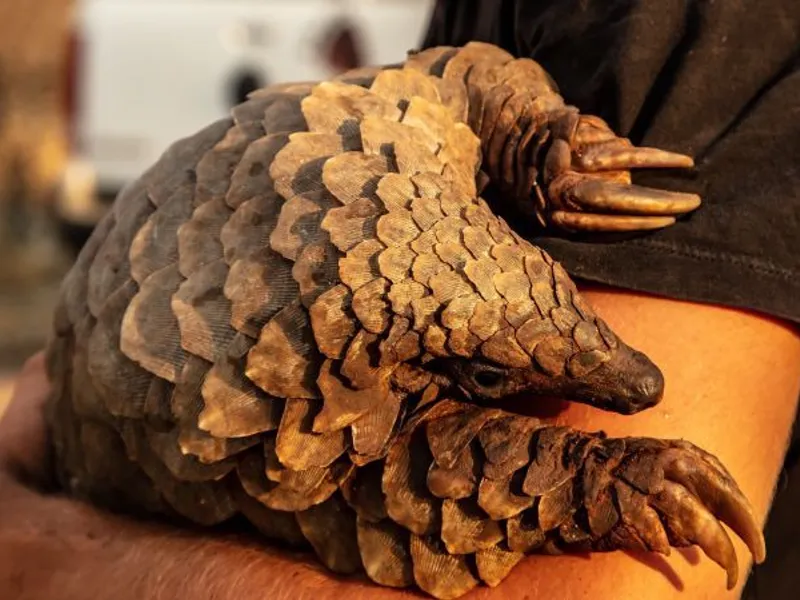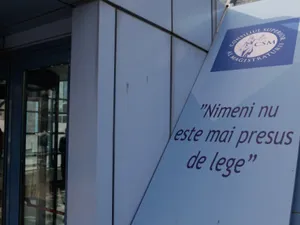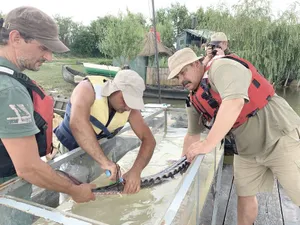Instead of wooden tables or chairs, they found 1.2 tons of scales stripped from poached pangolins, highly endangered mammals that look a bit like armadillos. A shipment of this size would be worth three million euros in China, where the scales are used in traditional medicine. So why was it heading to Romania?
Eastern Europe’s role in the illegal wildlife trade has received little attention. This is in part because of perceptions that trafficking is more of a problem in Western Europe, where many big seizures have been made. But there are also concerns among conservationists that smugglers are avoiding scrutiny by moving wildlife products through Eastern European countries with less stringent law enforcement.
To help understand trafficking patterns and trends, South Africa-based Oxpeckers Investigative Environmental Journalism and the Earth Journalism Network developed an online platform called #WildEye, which maps seizures, arrests, prosecutions and convictions related to illegal wildlife trade. The latest data on the platform, to which I have been contributing, make clear that Eastern Europe is an important region for wildlife traffickers. And it seems likely that many crimes go unnoticed and unpunished.
One of the main tools for regulating the wildlife trade is the Convention on International Trade in Endangered Species (CITES), which bans all trade in certain species and heavily restricts trade in others. Most countries are party to the treaty.
Each year, EU member states report their CITES-related seizures to a central database. An analysis of the 2018 data, published by the European Commission, revealed that authorities in the EU had seized CITES-listed species more than 6,000 times that year. The smuggled goods they seized included 2,825 pieces of elephant ivory weighing a combined 145 kg, as well as 1,135 live birds; 2,311 live reptiles; and thousands of other items derived from wildlife.
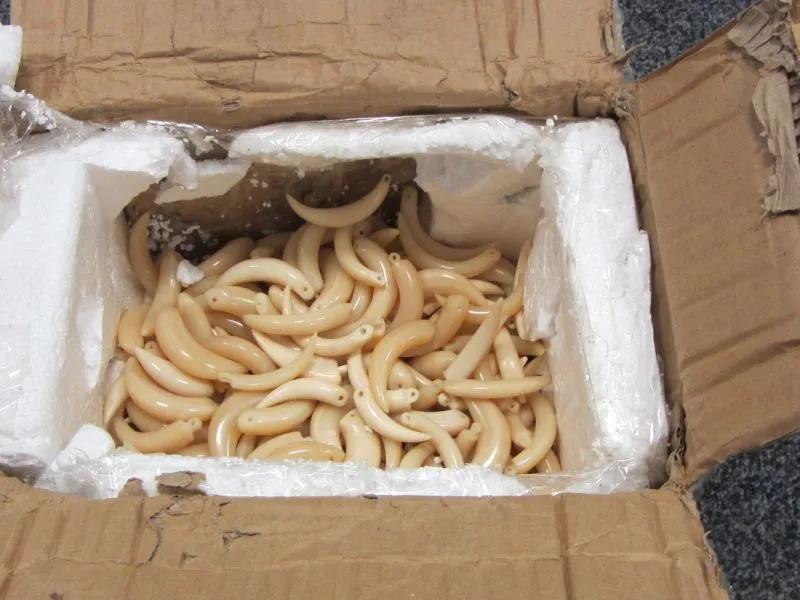
Elephant ivory seized at London’s Heathrow Airport on its way from Nigeria to China. Photo: Credit: UK Home Office / Creative Commons
The report revealed that Europe is indeed a major market, transit hub and source region for illegal wildlife products. But 79% of the seizures were made by just five countries in Western Europe — France, Germany, the United Kingdom, Spain and the Netherlands. While France had the largest number of seizures, with 1,256, countries in Eastern Europe made hardly any. Slovenia reported nine and Slovakia eight. Bulgaria reported five, and Romania just two.
There are various possible reasons for the East-West differences. Western Europe has more economic and cultural ties with Africa, the source of most CITES-listed products.
It also has many more large airports and seaports with direct links to Africa. Western Europe also has a larger population of people with Asian heritage, some of whom create demand for CITES products, such as medicine made with rhino horns.
But it is also possible that the uneven distribution of seizures reflects more active enforcement in Western European countries, and that many cases of illegal wildlife trafficking in Eastern Europe are simply going undetected. The new #WildEye data certainly suggests this.
It reveals that very high-value wildlife and wildlife products are travelling through Eastern Europe on their way to more lucrative markets. That shipment of Congolese pangolins bound for Romania was, for example, likely meant to be sent onward to Asia.
Seizures made by customs officers in other countries confirm that Romania is a source of illegal wildlife products. At the end of 2018, officials in Thailand found 700 kg of critically-endangered European glass eels that had been shipped illegally from Romania on a commercial flight.
The eels had a black-market value of more than one million euros. Yet nobody in Romania has been charged or arrested in connection with this crime, and the Romanian Border Police have made no public comment on the case.
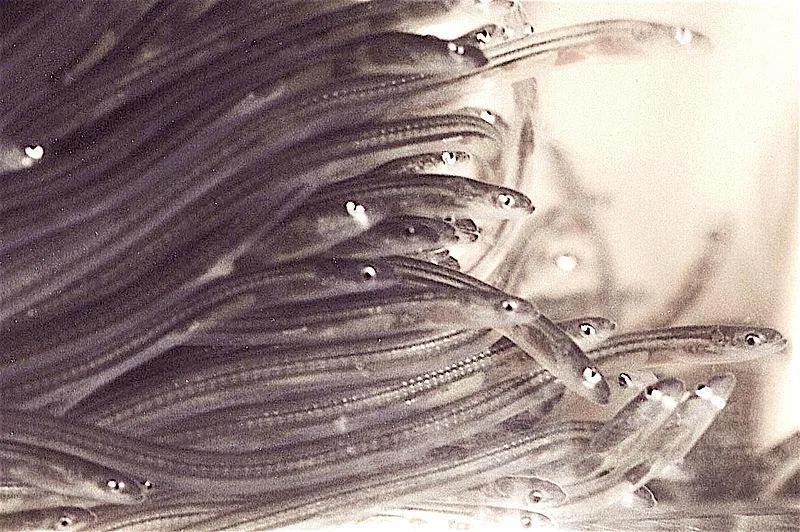
Each year, large numbers of critically-endangered glass eels are smuggled from Europe to Asia. The illegal trade is worth millions of euros Foto: Uwe Kils / Creative Commons
In another case, in 2017, a group of Italian men managed to smuggle 1,119 songbirds they had hunted illegally in Romania onto a flight back to their country. They packed the birds along with ice packs to preserve their meat for the market. The smugglers were caught when Italian authorities at Orio al Serio airport searched their luggage.
These cases show that Romania is both a source of illegal wildlife products and a conduit for goods trafficked from other source countries to lucrative markets in Asia.
But from my interactions with the Romanian Border Police and other authorities in Romania, it appears that they unprepared, overwhelmed or indifferent to the situation. In 2018, for example, Romania was the only EU member state to miss the deadline for reporting its confiscations to the EU’s central database.
Romania’s late report mentioned just two cases — the confiscation of two deer trophies by customs in Cluj-Napoca, and the Congolese pangolins seized in Turkey on their way to Romania. Yet when I asked the Inspectorate-General of Border Police for information about all wildlife product confiscations made in 2018-2020, they said “no such cases have been registered." When I asked why Romania has such a low rate of seizures, the Inspectorate-General declined to answer.
Cristina Muntean of WWF-Romania says officials need more training to help them detect wildlife crimes, in part because plant and animal parts are not always easy to identify. “CITES courses are of course needed, but not insignificant are collaborations with specialists to identify species, and more severe penalties for those who deal with this type of traffic.”
The new #WildEye data show that other Eastern European countries are also significant sources, markets or smuggling routes for illegal wildlife products. One trafficking hot spot the data reveal is the border between Ukraine and Poland. In 2018 and 2019 there were 91 incidents (mostly confiscations, but also a few arrests) involving both of these countries. The many species seized included live tigers, elephant ivory, caviar, tarantulas and live snakes, parrots and corals.
The vast majority of products were coming from Ukraine and were detected by Polish authorities across the border in Rzeszów. The existence of this hotspot makes the lack of seizures in Romania even more curious, since Romania also has a border with Ukraine. It is notable then that Polish authorities can make dozens of seizures at the border with Ukraine in one year, while Romania has not made a single seizure across its border in three years.
Moving further east, Russia also features prominently in the new data. A few examples highlight the nature of the problem.
In August 2018, white rhino horns were confiscated at Moscow’s Sheremetyevo Airport from the hand luggage of a 61-year-old Russian citizen arriving from Vilnius, Lithuania. He was arrested.
In November 2018, Russian authorities seized a ton of caviar from two residences in the city of Komsomolsk-on-Amur, and arrested two suspects. In September2019, Indonesian authorities in Bali caught a Russian man trying to smuggle a two-year-old orangutan in his luggage on a flight to Vladivostok.
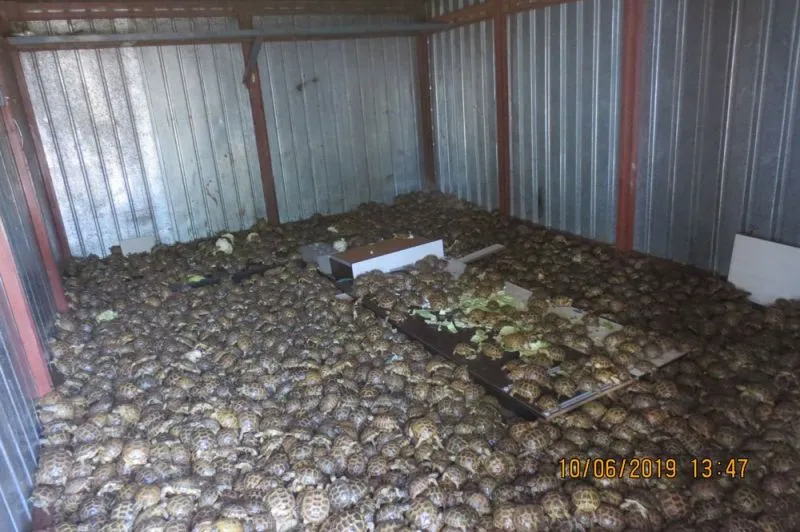
In June 2019, Russian customs officers discovered 4,100 Central Asian turtles in a truck crossing the border from Kazakhstan. Photo: World Customs Organization
And in October 2019, officials in Belarus prevented 10 live tigers from entering the country from Poland, on their way from Italy to an unlicensed zoo in the Russian Republic of Dagestan. Some experts believe the animals may have been destined for medicine markets in Asia. The emaciated tigers were in small cages in the backs of vehicles used for transporting horses and cattle. They were confiscated and are now in zoos in Poland and Spain.
That case is just one of more than a hundred — in eight Eastern European countries — that now appear on the #WildEye map. Together, these cases and the stories behind them paint a bleak picture of widespread trafficking, limited law enforcement, weak penalties and just few convictions. Based on what we know about how the illegal wildlife trade operates, it is likely that many of these cases were linked to organised crime and that some may have even been facilitated by corrupt officials.
But these cases are just the tip of the iceberg. According to Interpol, only 10 to 15 percent of illicit wildlife products transiting through all of Europe are seized. So, it is possible that somewhere in Eastern Europe tonight there is another shipping container hiding pangolin scales, another suitcase full of eels waiting to fly East, and another caged tiger being driven down a dark road to oblivion.
__________________________
This story was produced with support from the Internews Earth Journalism Network.
__________________________

